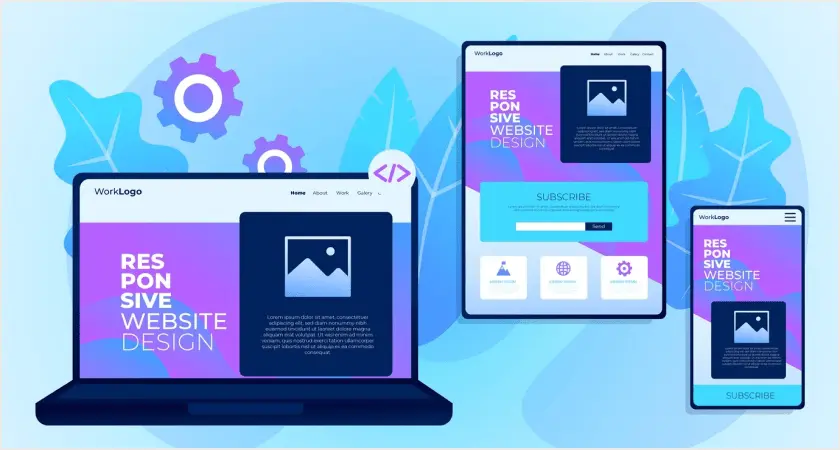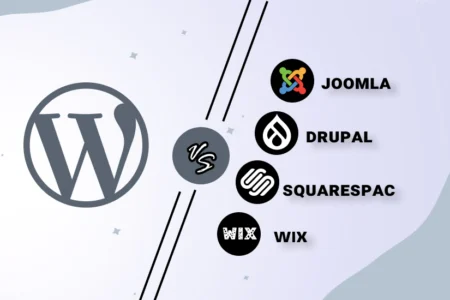The Latest Web Development Trends to Boost User Engagement and SEO in 2023

The web development landscape is constantly evolving, with new trends emerging all the time. As a business owner, it’s important to stay up-to-date on the latest web development trends to deliver a compelling and innovative web experience for your users. These trends include mobile-first web design, responsive web development, Progressive Web Apps (PWAs), schema markup for SEO, sustainable web development practices, data privacy, SEO-friendly web design, the latest web development technologies, and eco-friendly web design.
In this blog post, we’ll discuss some of the latest web development trends that can help you boost user engagement and SEO in 2023. Let’s explore the latest web development trends that are set to redefine the digital landscape this year.
Trend #1: Responsive Web Design for Mobile-First Experience

In an era where mobile devices have become an extension of ourselves, responsive web design has emerged as a digital imperative. This design philosophy ensures that websites adapt seamlessly to various screen sizes and resolutions, providing users with an optimal experience regardless of the device they use. Let’s delve into the significance of mobile-responsive design and the benefits it brings to the table.
Significance of Mobile-Responsive Design:
Mobile-responsive design is more than just a design trend; it’s a fundamental necessity. With a growing majority of internet users relying on smartphones and tablets, neglecting mobile optimization means alienating a substantial portion of your audience. A mobile-responsive website not only loads faster on mobile devices but also adjusts its layout and content to fit smaller screens. This adaptability is key to ensuring user satisfaction and engagement.
Benefits of Catering to Mobile Users:
- Improved User Retention: Mobile-responsive websites keep users engaged by providing a smooth and intuitive experience.
- Enhanced SEO Rankings: Search engines, such as Google, prioritize mobile-friendly websites in their rankings. By catering to mobile users, you not only improve user experience but also boost your chances of ranking higher in search results.
- Expansion of the Target Audience: The mobile-first approach opens up opportunities to reach a broader audience. Mobile users can access your website anytime, anywhere, making your content more accessible and shareable.
- Increased Potential for Conversions: A mobile-responsive design ensures that users can complete actions like filling out forms or making purchases on smaller screens without frustration.
Trend #2: Progressive Web Apps (PWAs) for Enhanced User Experience

Progressive Web Apps (PWAs) are revolutionizing the digital landscape. These web applications combine the speed and convenience of mobile apps with the accessibility of websites. They load lightning-fast, work offline, and offer push notifications to keep users engaged. Unlike traditional apps, PWAs are easily shareable via a URL, eliminating the need for app store downloads. This user-centric approach enhances engagement, boosts retention, and simplifies access. PWAs are the future of web development, offering businesses a powerful tool to provide users with a seamless and engaging experience.
Trend #3: Single-Page Applications (SPAs) In Latest Web Development Trends

SPAs (Single-page applications) are a type of web application that loads a single HTML page and dynamically updates that page as the user interacts with it. This is in contrast to traditional web applications, which load a new page for each interaction.
SPAs are often used to create fast and responsive web applications, as they do not have to reload the entire page each time the user interacts with it. This can make SPAs feel more like native mobile applications, which is why they are often used to create mobile-friendly web applications.
Here are some of the advantages of SPAs:
- Faster and more responsive: SPAs are often faster and more responsive than traditional web applications because they do not have to reload the entire page each time the user interacts with it.
- Better user experience: SPAs can provide a better user experience than traditional web applications because they can feel more like native mobile applications.
- Easier to develop: SPAs can be easier to develop and maintain than traditional web applications because they use a single codebase for both the front-end and back-end.
However, there are also some disadvantages to SPAs:
- Can be more difficult to SEO: SPAs can be more difficult to optimize for search engines than traditional web applications because they do not load new pages for each interaction.
- Can be more difficult to debug: SPAs can be more difficult to debug than traditional web applications because they can be more complex and dynamic.
- Can be more difficult to load on slow networks: SPAs can be more difficult to load on slow networks than traditional web applications because they often require more JavaScript code to run.
Trend #4: Core Web Vitals for SEO and User Satisfaction

Focusing on these Core Web Vitals is essential for improving both SEO rankings and user satisfaction. Websites that prioritize these metrics provide a faster, more responsive, and visually stable experience, resulting in higher search engine rankings and happier users.
Trend #5: AI-Powered Chatbots for User Engagement

AI chatbots have revolutionized user interactions, offering businesses a powerful tool to engage customers and reduce bounce rates. By leveraging natural language processing and machine learning, chatbots can provide instant, 24/7 support, answer queries, and guide users through websites, resulting in longer, more meaningful interactions.
Here are some successful chatbot implementations that span various industries and use cases. Here are a few examples:
- Customer Support Chatbots: Many companies, such as IBM and Autodesk, have integrated chatbots into their customer support systems. These chatbots can handle common customer inquiries, troubleshoot issues, and provide quick solutions, resulting in improved response times and reduced support costs.
- E-commerce Assistants: Retailers like Sephora and H&M have chatbots that help customers find products, offer personalized recommendations, and even facilitate the purchase process. These chatbots enhance the shopping experience and boost sales.
- Healthcare Chatbots: Health-related chatbots, like Buoy Health, provide users with symptom analysis and medical advice. These chatbots assist users in understanding their health concerns, reducing unnecessary doctor visits and relieving some of the pressure on healthcare professionals.
- Educational Chatbots: Educational institutions, such as Georgia State University, use chatbots to assist students with course registration, answer academic questions, and provide resources. These chatbots improve student engagement and streamline administrative processes.
Trend #6: Schema Markup for Rich Snippets and SEO Benefits
Schema markup, also known as structured data, is a code added to web pages to provide search engines with specific information about the content on those pages. It helps search engines better understand the context and meaning of the content, which can lead to rich snippets in search results. Rich snippets are enhanced search results that display additional information like star ratings, product prices, and event dates, making them more appealing to users.
The SEO benefits of schema markup include improved click-through rates, increased visibility, and a potential boost in organic traffic as search engines use this data to generate more informative and visually appealing search results. It’s a valuable tool for website owners and businesses looking to stand out in search engine results pages.
Trend #7: Sustainability in Web Development

Sustainability in web development refers to the practice of creating and maintaining websites with a focus on reducing their environmental impact, optimizing resource use, and ensuring ethical and inclusive design and content. This approach aims to make web development more responsible and environmentally friendly.
Importance of Eco-Friendly Web Development:
- Reducing Environmental Impact: Eco-friendly web development minimizes energy consumption and carbon emissions, which is crucial in an era of increasing digital dependence where data centers contribute to environmental degradation.
- Resource Conservation: It promotes efficient use of resources like bandwidth and server space, which reduces the need for energy-intensive data storage and transmission.
- Improved User Experience: Sustainable websites tend to load faster and offer better performance, enhancing user experience and engagement.
- Cost Savings: Optimized web development practices can lead to reduced hosting and energy costs, making it financially beneficial for businesses.
- Ethical Considerations: Eco-friendly web development aligns with ethical and social responsibility, contributing to a more inclusive, accessible, and trustworthy online environment.
- Long-Term Viability: By reducing waste, sustainable web development can contribute to the long-term viability of digital resources, fostering a more enduring web presence.
Trend #8: Data Privacy and User Trust

Data privacy is the right of individuals to control their personal information. It includes the ability to choose who has access to their data, what data is collected, and how it is used. Data privacy is important because it protects individuals from identity theft, fraud, and other forms of harm.
There are many ways to build user trust, but some of the most important include:
- Transparency: Be clear and upfront about what data you collect, how you use it, and who has access to it.
- Control: Give users control over their data, including the ability to opt out of data collection and to request access to their data.
- Security: Implement strong security measures to protect user data from unauthorized access, use, or disclosure.
- Accountability: Hold yourself accountable for protecting user data. This includes being responsive to user inquiries and concerns and taking steps to address any data breaches that may occur.
Conclusion
In conclusion, the latest web development trends offer exciting opportunities to revolutionize your online presence, boost user engagement, and improve SEO. By embracing mobile-first web design, responsive web development, Progressive Web Apps (PWAs), schema markup for SEO, sustainable web development practices, data privacy, SEO-friendly web design, latest web development technologies, and eco-friendly web design, you can ensure that your website stands out from the competition and captivates users. So, don’t hesitate to incorporate these trends into your web development strategy and take your online presence to new heights in 2023.
FAQs
Do you have any questions about the latest web development trends? We have answers to some frequently asked questions on the topic.
What are the benefits of implementing the latest web development trends?
The benefits of implementing the latest web development trends include:
- Improved user experience
- Increased user engagement
- Higher SEO rankings
- More leads and sales
How much does it cost to implement the latest web development trends?
The cost of implementing the latest web development trends will vary depending on the specific trends that you want to implement and the complexity of your project. However, there are a number of ways to implement these trends for a relatively low cost.
Do I need to be a developer to implement the latest web development trends?
No, you do not need to be a developer to implement the latest web development trends. There are a number of different resources available that can help you to get started. For example, there are many different website builders and content management systems (CMS) that offer features that can help you implement the latest web development trends.
Hi, This is Biplob Hossain. I am professional content writer. I successfully wroten a lot of content about Web development topics. I am also good web developer.
Related Articles

WordPress vs. Other Content Management Systems: Why WordPress is the Superior Choice
WordPress is the most popular CMS in the world for a reason. It's easy to use, customizable, scalable, and secure. Learn why WordPress is the superior choice for your...

The Ultimate Guide to Web Developer Selection: Finding the Perfect Match for Your Needs
Discover the essential steps to choose the perfect web developer selection for your project. From defining your goals to evaluating skills and collaboration, this guide has you covered.

How WordPress Can Help You Build a Strong Online Presence For Your Business
Building a strong online presence with WordPress can help you create a professional website, publish high-quality content, promote your website online, and track your results.